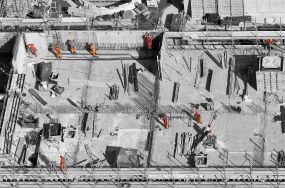1. Site Assessment
- Inspect the Site: Conduct a comprehensive walkthrough of the construction site, noting areas with significant debris buildup, potential hazards, and specific cleaning requirements. Create a checklist to ensure no area is overlooked.
- Safety Measures: Assess the need for safety gear such as hard hats, gloves, safety goggles, and protective clothing. Ensure that all personnel are aware of and adhere to safety protocols. Identify any specific training needs for handling hazardous materials.
2. Debris Removal
- Clear Large Debris: Begin by collecting and removing large debris. Use wheelbarrows, dumpsters, and heavy-duty garbage bags to transport debris. Sort materials for recycling when possible, separating wood, metal, and other recyclables.
- Dispose of Waste Properly: Familiarize yourself with local waste disposal regulations. Partner with waste management services to ensure compliance and efficient disposal. Use designated bins and containers for different types of waste to facilitate proper disposal and recycling.
3. Dust and Dirt Removal
- Sweep and Vacuum: Start with sweeping the floors to collect loose dirt and dust. Use industrial vacuum cleaners for thorough removal of fine dust from floors, walls, and ceilings. Pay attention to corners, edges, and other hard-to-reach areas.
- Wipe Down Surfaces: Use microfiber cloths and appropriate cleaning solutions to wipe down all surfaces, including windows, fixtures, and equipment. For stubborn dust or grime, consider using a damp cloth followed by a dry wipe to ensure no residue remains.
4. Hazardous Material Handling
- Identify Hazardous Materials: Conduct a thorough review to identify any hazardous materials such as lead, asbestos, or chemical residues. Use specialized detection equipment if necessary.
- Proper Disposal: Follow strict guidelines for the handling and disposal of hazardous materials. Work with certified disposal services and ensure that all hazardous waste is transported and disposed of in accordance with local and federal regulations.
5. Cleaning Tools and Equipment
- Use Appropriate Tools: Equip your cleaning team with the right tools for the job. This includes brooms, mops, pressure washers, vacuums, and specialized cleaning agents. Ensure tools are suitable for the materials and surfaces being cleaned to avoid damage.
- Maintain Equipment: Regularly inspect and maintain cleaning equipment to ensure efficiency and safety. Replace worn-out parts and perform routine maintenance checks to prevent equipment failure.
6. Final Inspection
- Conduct a Walkthrough: After the initial cleaning, perform a detailed walkthrough to ensure all areas meet the required cleanliness standards. Look for missed spots, residue, or areas that need additional attention.
- Document the Process: Keep detailed records of the cleaning process, including before-and-after photos, checklists, and notes on any issues encountered. This documentation can be useful for quality control and future reference.
7. Site Preparation for Next Phase
- Organize the Site: Arrange materials and tools in an orderly manner to prepare for the next phase of construction. Clear pathways and workspaces to facilitate easy access and movement.
- Communicate with Team: Brief the construction team on the cleaned areas, any changes made, and any precautions they need to take. Ensure everyone is aware of the location of materials and tools.
Tips for Effective Pre-Construction Cleaning:
- Plan Ahead: Develop a detailed cleaning schedule that aligns with the construction timeline. Coordinate with the construction manager to integrate cleaning activities seamlessly.
- Train the Team: Provide comprehensive training to the cleaning team on safety protocols, the proper use of equipment, and effective cleaning techniques. Conduct regular safety drills and refresher courses.
- Use Eco-Friendly Products: Choose cleaning products that are environmentally friendly and safe for use around construction materials. Look for certifications and eco-labels to ensure the products meet environmental standards.
- Monitor Air Quality: Install air purifiers or ensure proper ventilation to maintain good air quality. Regularly monitor for dust levels and take steps to minimize airborne particles.
Additional Considerations:
- Weather Conditions: Consider the impact of weather on the cleaning process. Rain, wind, and extreme temperatures can affect cleaning efficiency and safety.
- Security Measures: Ensure the site is secure during and after cleaning to prevent unauthorized access and potential theft of materials and equipment.
- Cost Management: Track cleaning costs and budget accordingly. Optimize resources to ensure cost-effective cleaning without compromising quality.
By thoroughly addressing these aspects, pre-construction cleaning can significantly enhance the safety, efficiency, and success of a construction project. This detailed approach ensures that the site is not only clean but also well-organized and ready for the subsequent phases of construction, contributing to the overall quality and timeliness of the project.



0 Comments